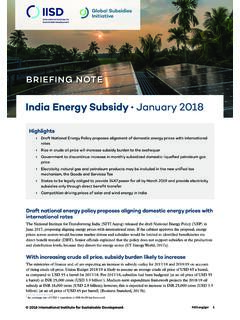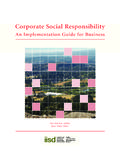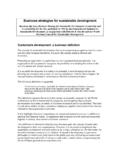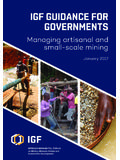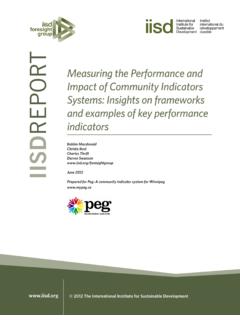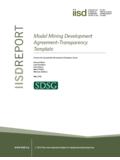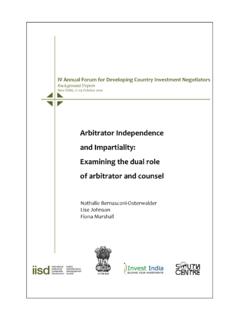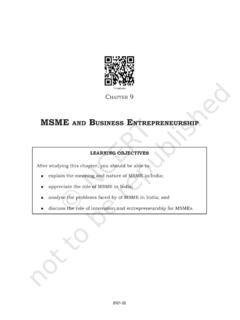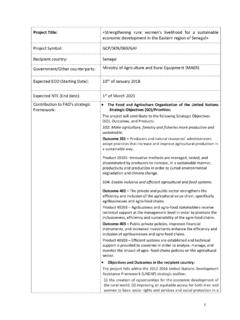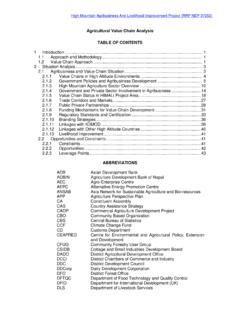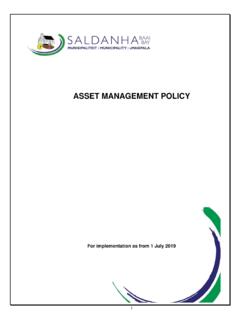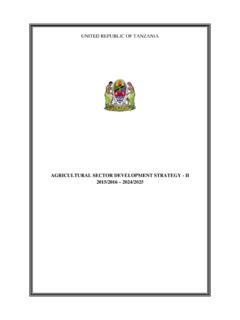Transcription of Financing for Agriculture: How to boost opportunities in ...
1 2015 International Institute for Sustainable 1 Financing for agriculture : How to boost opportunities in developing countriesMarina RueteSeptember 2015 INVESTMENT IN AGRICULTUREP olicy Brief #31. IntroductionAccess to finance is critical for the growth of the agriculture sector. The shift from subsistence to commercial agricultural production requires funds. However, in developing countries, where agriculture is a source of livelihood for 86 per cent of rural people (International finance Corporation [IFC], 2013), Financing for investments in agriculture is scarce, even for large investors. In Africa, less that 1 per cent of commercial lending is destined to the agriculture sector (IFC, 2013).
2 Financial institutions are reluctant to accept the risks prevalent in the agricultural sector, such as droughts, floods, pests and diseases, or the transaction costs of covering large geographical distances. Consequently, although governments are now making efforts to attract investment for agriculture , the lack of understanding of the financial risks and opportunities in agriculture , deprives the sector of much-needed funds to boost production, processing and marketing. This policy brief explores the financial needs of agriculture in developing countries and the instruments available to address these needs. We examine the challenges in obtaining Financing for agricultural investments, the role of different actors, and the options for governments to enhance the legal and policy environment of the financial system to support agricultural development.
3 2. Challenges of agricultural FinancingSimilar to other sectors, those who invest in agriculture , particularly local farmers, but also foreign-owned plantations, processing factories, storage facilities or fertilizer companies, may need funds from third parties to carry out their businesses. However, in the current global financial system, a number of factors frustrate the development of solid financial services in rural areas in most developing countries. First, transaction costs in rural areas are higher than in urban areas due to a more dispersed population with weak infrastructure (International Fund for agricultural Development [IFAD], 2009a).
4 Second, and more importantly, the risk factors inherent in agriculture often inhibit financial institutions from lending. These include production risks linked to natural hazards (such as droughts, floods and pests), farmers weak ability to provide collateral (either because the farmer lacks title to land to offer as a loan guarantee or the value of the land may be too low) and the volatility of prices (IFAD, 2009a). Third, the financial sector may not be sophisticated enough in some developing countries. The availability and innovation on sector-specific financial instruments and services is usually poor. Also, although financial services may be available, they may not be suitable for all types of agricultural activities, which will have diverse needs with respect to timing for disbursements, amounts and risks, INVESTMENT IN agriculture Policy Brief #3 Financing for agriculture : How to boost opportunities in developing 2among others.
5 For example, in seasonal farming, funding is needed in particular stages of the production process (IFAD, 2009a). At the same time, the offer of financial products may only be available to large-scale farming operations with sound track records, and therefore may not meet the specific needs of the , the lack of records and statistics on farming in developing countries makes assessment of credit suitability challenging for financial providers. This changes the conditions required to access financial products and undermines opportunities for profitable Who Needs finance in the agriculture Sector? agriculture encompasses a broad range of activities from small-scale farming to infrastructure projects to research and development.
6 As a result, when referring to agriculture finance , the market clusters it in four groups. The groupings correspond to different approaches to addressing the needs of the sectors: (1) the needs of farmers and entrepreneurs, (2) the transactions between the actors along the value chain , (3) infrastructure needs and (4) generating knowledge to support the sector. 1. Farmers and small agricultural entrepreneurs: This approach is focused on the actors in the agriculture sector that need Financing . Farmers and small entrepreneurs, like small supply companies, need finance to allow them to expand production and/or diversify products. This can include, for example, finance for inputs (such as seeds and fertilizers), production (such as machinery and equipment) and marketing (such as processing, packaging and transport) (Food and agriculture Organization [FAO] & World Bank, 2013).
7 2. Actors along the value chain : The focus is on the links between different actors along a value chain . agriculture entails a sequence of interlinked activities transactions in a chain that starts from the supply of seeds and fertilizers and finishes in the mouth of the consumers (IFAD, 2012). There are financial instruments specifically designed to strengthen these links between the actors along the value chain . 3. Rural infrastructure: Financing can be also concentrated on the infrastructure needed to carry out agricultural activities. The sector depends heavily on infrastructure such as rural transport systems, irrigation systems, water supply, sanitation, electricity, storage and telecommunication facilities.
8 These projects are costly and require large amounts of Research and Development (R&D): This last approach focuses on financially supporting knowledge generation for the sector. This includes the generation of agricultural technology and new technical knowledge about products, processes and services for the sector (Anandajayasekeram, 2011). R&D also provides valuable knowledge to help producers prepare business plans for banks or other financial institutions, to support financial planning and credit assessment by financial institutions, and government planning in general. 4 . An Overview of Financial Instruments for the Rural SectorDifferent financial instruments respond to different needs in the agriculture sector.
9 Within each of the four groups, the financial instruments depend on the level of sophistication of the financial system in each country, and the willingness of the financers to take the risks in that particular market. Regulation and awareness programs also play a key role in the response to the financial needs. In addition to local financial institutions, foreign banks, development banks, governments and even actors in need of financial assistance, also provide financial solutions. This section describes some of the available financial instruments and initiatives generally used in different countries. Direct finance Financing a particular actor of the agriculture sector is the traditional approach to Financing in developing countries.
10 This includes not only farmers but also other actors, such as input suppliers, processors, traders and exporters. All need Financing to get food from the farm to the consumers. The following financial instruments are available:INVESTMENT IN agriculture Policy Brief #3 Financing for agriculture : How to boost opportunities in developing 31. Savings. An informal financial sector exists in countries all over the world, particularly in least developed countries, and provides for basic access to finance . The Financing comes from the actors themselves. In many countries, it takes the form of community savings and non-formalized group Financing mechanisms.
